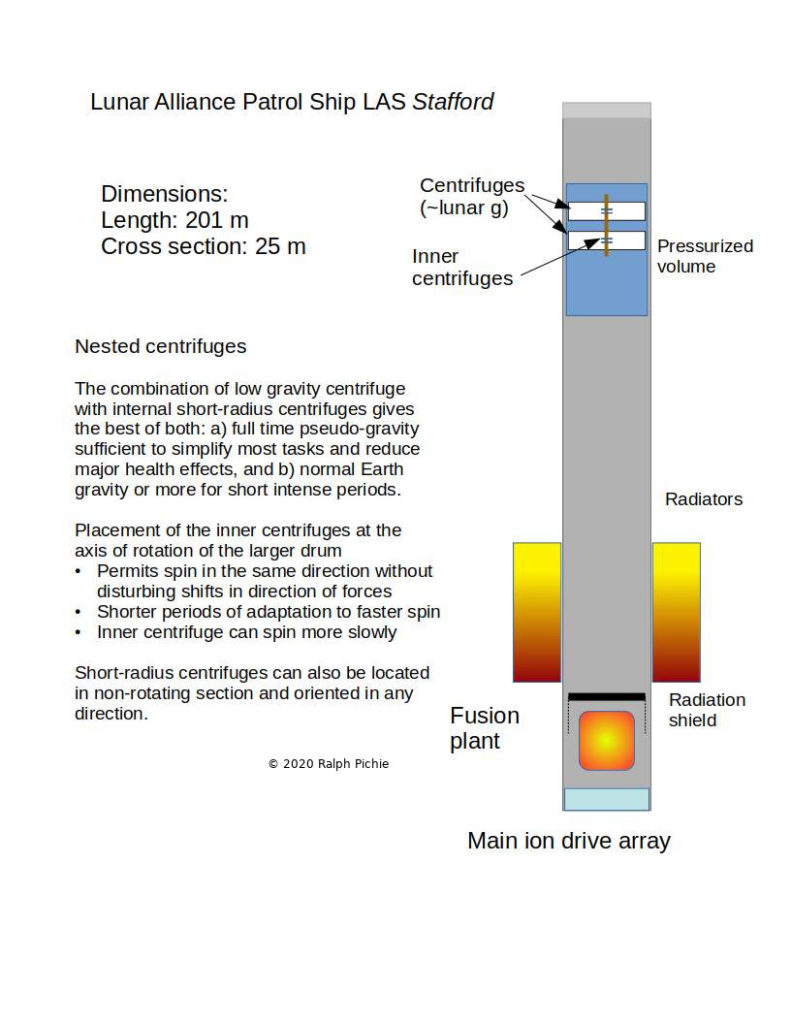Fifty years after 2001: A Space Odyssey gave us the vision of a giant rotating space station, we still don’t have artificial gravity in space, and no near term prospect of it. Instead, there is an aging space station that can house a small crew of half a dozen in microgravity, essentially weightless, with all the health effects and productivity drains that entails.

Fiction gives us optimistic visions of huge rotating station and ships that generate gravity by unmentioned methods. None of that is remotely possible without a vast and robust space infrastructure or new physics.
Faced with physics that requires a radius of at least 220 meters to have full gravity that won’t cause problems for anyone, and all the cost that implies, researchers have tried to find ways around the limitations using gradual adaptation to higher rates of spin to reduce the size. Even then, the radius can only get so small before coriolis and other effects become disruptive. Also problematic is the large cross section required for a ship with internal centrifuge, which presents a big target for debris to impact, and a big area that has to be protected with shielding.
A common proposal is to connect two sections by a tether and spin the contraption to create a feeling of gravity. That works, and it does save mass over a full-sized rigid structure, but it comes with limitations. Course changes are not easy when your ship is a pair of weights connected by a tether. It’s a useful design, but

Some proposals have completely abandoned the idea of providing full time gravity, opting instead for a short-radius design that offers intense periods of rapid spin with the occupant seated or ‘standing’ against the centrifugal pseudo force.

It’s impossible to do much beyond a bit of isometrics or cycling or strictly mental work while being spun in a device such as this. It can save mass and expense, and will perhaps have a place in relatively small ships with short duration missions or small crews. Aligning the plane of rotation of a short radius centrifuge gym with the long axis of a ship lets it fit in a cylinder of 4 or 5 meters diameter while still leaving gaps through which crew and conduits can pass. Wider cylinders can have the ‘spin gym’ rotating around the center line of the ship like the type of drum you see shown in science fiction. That latter arrangement leads to a better way to achieve useful artificial gravity in a relatively compact space ship design.
One morning, laying in bed thinking about a space station and a ship in a story I’m working on, I realized two things:
- There are really only three levels of gravity in the solar system that are significant for future settlement.*
- Full gravity: Earth 1 g and Venus 0.89 g
- Mars and Mercury ~0.38 g
- Lunar gravity (0.165 g), similar to the larger moons of Jupiter and Saturn
- Short-radius centrifuges can be nested within a relatively compact outer centrifuge that provides lower levels of simulated gravity. The outer drum is large enough to prevent the worst medical effects and aid productivity, while the need for higher acceleration is filled by exercise in the internal spin gym.
But, you say, the spinning of two centrifuges will cause all kind of nasty effects, not least of which would be nausea. True, except when the axis of the inner short-radius centrifuge is in line with the outer centrifuge, and the two are spinning in the same direction. That means that the rotational axis of the outer centrifuge must be blocked by the spin gym, but that’s more an inconvenience than a show stopper.
The Apollo lunar missions showed that one-sixth gravity was enough to alleviate some of the worst effects of microgravity on the body, and to hold things down where they are placed.

A single set of nested centrifuges is the simplest configuration, but I’ve chosen to show two counter-rotating ‘drums’ to show how a larger crew might be accommodated.

I chose lunar gravity rather than some arbitrary partial value of Earth gravity because Luna will be a major destination and ease of adjustment for crew and passengers is important. One-sixth gravity gives the smallest possible outer centrifuge radius and thus the greatest mass saving. Later, with more traffic to and around Mars, and perhaps Mercury, larger drums offering 0.38 g as well as lunar gravity will become more common.